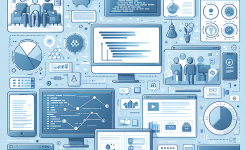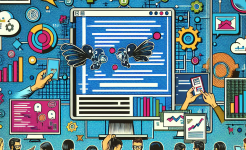Lack of Agility and Adaptability
One of the most significant drawbacks of traditional development methods is their inherent lack of agility. Traditional approaches often follow a rigid, sequential process, such as the waterfall model, where each phase must be completed before moving on to the next. This linear structure leaves little room for flexibility or adjustment during the development cycle. In a rapidly changing market environment, where customer needs can shift overnight and new technologies emerge constantly, this lack of agility can be a major handicap.
For instance, in the software development industry, a traditional waterfall approach might require a detailed requirements specification upfront. Once the development process begins, any changes to the requirements can be extremely costly and time-consuming to implement. This is because the entire project plan, design, and code might need to be revised. In contrast, agile development methodologies, which have gained popularity in recent years, allow for more frequent changes and adaptations. They break the development process into smaller, iterative cycles, enabling teams to respond quickly to new information or changing circumstances.
Moreover, traditional development methods often struggle to keep up with the speed of innovation. The long development cycles associated with these methods mean that products or services may be obsolete by the time they are finally launched. In today's hyper-competitive market, being able to bring new offerings to the market quickly is crucial for success. Companies that rely on traditional development methods may find themselves falling behind their more agile competitors, who can continuously iterate and improve their products based on real-time feedback.
Poor Collaboration and Communication
Another major shortcoming of traditional development methods is the lack of effective collaboration and communication among different stakeholders. In traditional setups, different teams, such as development, design, and marketing, often work in silos, with limited interaction and information sharing. This can lead to a disconnect between what the customer wants and what the development team is building.
For example, the marketing team may have a clear understanding of the market trends and customer preferences, but this information may not be effectively communicated to the development team. As a result, the product that is developed may not meet the customer's expectations, leading to wasted resources and missed opportunities. Similarly, the design team may create a visually appealing product, but if they do not collaborate closely with the development team, there may be technical limitations that prevent the design from being fully realized.

In addition, traditional development methods often rely on formal documentation and hierarchical communication channels. This can slow down the decision-making process and make it difficult for teams to quickly address issues or make adjustments. In contrast, modern development approaches, such as agile and lean, emphasize face-to-face communication, collaboration, and cross-functional teams. These methods encourage open and transparent communication, enabling teams to work together more effectively and make informed decisions in a timely manner.
Furthermore, the lack of collaboration can also lead to a lack of ownership and accountability among team members. When teams work in isolation, it can be difficult to determine who is responsible for a particular aspect of the project. This can result in finger-pointing and a lack of motivation, as team members may not feel a sense of ownership or pride in the final product.
Inefficient Resource Allocation
Traditional development methods often suffer from inefficient resource allocation. In these methods, resources are typically allocated based on a fixed project plan, which may not accurately reflect the actual needs of the project as it progresses. This can lead to over-allocation of resources in some areas and under-allocation in others, resulting in wasted time and money.
For example, in a construction project using a traditional development method, a large portion of the budget may be allocated to the initial design and planning phase. However, if unforeseen issues arise during the construction process, such as changes in building codes or unexpected geological conditions, there may not be enough resources available to address these issues. This can lead to delays, cost overruns, and a lower quality final product.
Moreover, traditional development methods often do not take into account the uncertainty and variability that are inherent in any project. They assume that everything will go according to plan, and do not have mechanisms in place to adjust resource allocation based on changing circumstances. In contrast, modern project management approaches, such as risk-based management and value-driven delivery, focus on identifying and managing risks early in the project and allocating resources based on the potential impact of these risks.
In addition, the inflexible resource allocation in traditional development methods can also lead to a lack of innovation. When resources are tightly constrained and allocated according to a fixed plan, there is little room for experimentation or exploration. This can prevent teams from coming up with new and creative solutions, and limit the potential of the project to deliver truly innovative products or services.
In conclusion, traditional development methods have several significant drawbacks that can impede the success of projects in today's dynamic business environment. The lack of agility and adaptability, poor collaboration and communication, and inefficient resource allocation can all lead to missed opportunities, increased costs, and lower quality products or services. To remain competitive, organizations need to embrace modern development approaches that address these limitations and enable them to respond quickly to changing market conditions, collaborate effectively, and allocate resources more efficiently. By doing so, they can increase their chances of delivering successful projects that meet the needs of their customers and drive business growth.
ARTICLE TITLE :Three major drawbacks of traditional development methods ,AUTHOR :ITpmlib

















